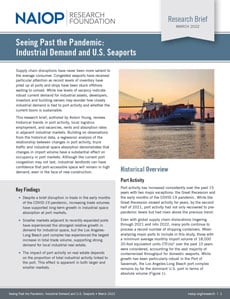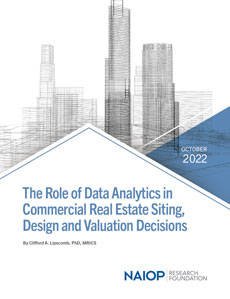What Lies Ahead for Commercial Real Estate?

NAIOP brought together national research directors and academics to discuss the return to the office, the future of industrial and other topics.
The NAIOP Research Foundation held its National Research Directors Meeting in October during CRE.Converge in Chicago. The discussion, led by Shawn Moura, Ph.D, NAIOP’s director of research, focused on the outlook for office and industrial properties amid a rapidly changing economic climate. The meeting featured some of the NAIOP Research Foundation’s Distinguished Fellows as well as research directors from national real estate brokerage, data and investment firms.
Office Outlook
Nearly three years after the COVID-19 pandemic closed businesses and forced millions into remote work, the office sector remains somewhat in a state of limbo, according to participants in the panel discussion.

Aaron Ahlburn,
Avison Young

John Chang,
Marcus & Millichap

Matt Dolly, Transwestern

Brian Harper, Avison Young

Clifford A. Lipscomb, Ph.D., MRICS, Bartow Street Capital

Stephen Newbold, Colliers

Carlos Ortea,
The Davis Companies

Amanda Ortiz, Colliers

Mirle Rabinowitz-Bussell,
University of California-San Diego

Drew Richardson,
Primera Companies, Inc.

Steig Seaward, Colliers

Mark Stapp,
Arizona State University

Dean Violagis, Costar

Raymond Wong,
Altus Group
Dean Violagis, vice president of research with CoStar who is based in Washington, D.C., noted that while newer, well-leased office properties remain a safe investment, Class C properties are not faring well.
“In Washington, I’m seeing a lot of people buying buildings and converting them to other uses like multifamily, which is a good thing,” he said. “Cities need more housing. The question is, is it always going to be profitable? Because that’s not an easy task. But clearly, the office sector is feeling some pain. There’s a tremendous amount of subleased space. It keeps going up, and it has an impact on the market.”
Stephen Newbold, director of national office research with Colliers, said the office market is facing a lack of clarity on both the leasing and investment sides.
“People are stepping back from making decisions right now,” he said. “Many of them are less comfortable with office in their investment portfolio. Some investors are reassessing their office exposure. We’re not seeing repricing yet, but we are seeing some properties being taken off the market, or leveraged acquisitions becoming more of a challenge to underwrite because of rising interest rates.”
According to Newbold, for the 12-month period from mid-2021 to mid-2022, national vacancy has tracked around 15%. (Research shows that the record high was 16.3% at the peak of the Global Financial Crisis.)
“Absorption has come back, albeit at a modest level” he said. “The 150-million-square-foot loss we had during the COVID period is back to slightly net positive by about 15 million square feet over the past 12 months.”
However, Newbold is concerned about sublease space as well. He said it started to drop in the second half of 2021, but it’s ratcheted back up, and it’s currently just shy of 220 million square feet, a record level.
“Recent leasing activity provides evidence that large occupiers are downsizing their office space,” he said. “However, unless there is an imminent lease expiration, firms may delay decisions until there is greater clarity on the outlook for business and the economy.”
For example, Newbold said Yelp, driven by an increase in remote work, cut its office space in San Francisco from 160,800 square feet to 53,600 square feet.
“If you look across the major central business districts (CBDs), asking rents for Class A sublease space are about 30% to 35% less than for direct space,” he said. “Whether it’s through sublease space or tenant downsizing, I expect more space to be added to availability. You can’t repurpose all that space to other uses such as multifamily or life sciences.”
Drew Richardson, director of leasing and property management with Primera LLC in Plano, Texas, and a NAIOP Research Foundation Governor, said he believes many companies will reduce their space commitments when their leases expire.
“If they signed a five-year lease or a six-year lease in late 2019 and they’ve got to survive that, by the time the cycle goes back around, they may exit or sublease unused space,” he said. “They may be waiting the lease out just to keep the employees there. There’s going to be a lot of that as companies adjust to the future of the office.”
Newbold agreed, citing a recent Colliers survey in which roughly half of the respondents indicated that they would want a shorter lease when renewing or relocating.
Hybrid Work and CBDs
The pandemic may have permanently altered attendance requirements for office workers, which could have far-reaching implications for both office markets and the health of central business districts.
Previously, most white-collar employees were in the office five days a week. Today, that number is expected to range from two to three days a week. However, Raymond Wong, vice president of data operations with the Altus Group in Toronto, said different demographic groups may have different definitions of the “perfect” number of days in the office.
“In the last 18 months, there was growth in the tech sector and life sciences that took up some of that space, especially life sciences in the suburbs,” he said. “But you’ve got to look at demographics. People of a certain age do not prefer to go back to the office, such as those whose careers are near the end or those who are early in their career. As for the mentality that you must be in the office to advance your career or to bump into the senior managers, well, some of the senior managers aren’t there. Commute times also play a factor in the larger urban markets. Traveling two to three hours to and from work is just not that desirable anymore.”
Most panelists agreed that hybrid work is here to stay — at least for the foreseeable future.
“Whether it’s three days in and two days out, I think most office occupiers of scale are saying they’re going to adopt some level of hybrid work, but many are still defining the details,” Newbold said, adding that smaller businesses are seeing a higher share of employees back in the office.
Carlos Ortea, director of research with The Davis Companies, said it’s important to differentiate between office markets in Sunbelt cities and gateway cities.
“South Florida is one of the top-performing office markets right now, but I don’t know how long that will last,” he said. “Markets like Charlotte or Raleigh or Texas appear to have some strong employment drivers for the return to the office.”
Many gateway cities, on the other hand, are still seeing high vacancy rates for office properties. According to JLL’s U.S. Office Outlook for the third quarter of 2022, cities such as Chicago, San Francisco, Boston and Washington, D.C., all have office vacancy rates approaching or exceeding 20%. Empty offices greatly reduce foot traffic and spending at nearby retail establishments and restaurants. That, in turn, has led to an increase in the perception that vacant streets in many CBDs are unsafe or more vulnerable to crime.
“It’s interesting to think about the effect on all the services that were created to support all those workers in the CBDs,” said Mark Stapp, executive director of the Masters of Real Estate Development program at Arizona State University. “Urban retail in places where office workers are not returning is dying because of this lack of demand and foot traffic, and that exacerbates this issue of safety and crime, because there are fewer people and fewer eyeballs on the street. Activity is a basic crime deterrent.”
A University of California, Berkeley study of downtown activity in major cities from March to May 2022 based on cellphone location data showed that many are seeing less than half of the foot traffic they saw before the pandemic. San Francisco is at just 31% of pre-pandemic levels.
Stapp noted that while crime in CBDs has always been a fact of life, it’s been exacerbated by social media and the ubiquitous presence of cellphone video cameras.
“Negative perceptions can now be perpetuated so much faster,” he said. “This then begins to play out in people’s decision-making, then it becomes a self-fulfilling prophecy. Suddenly, downtown doesn’t look occupied. You’ve got vacant storefronts, and fewer people working in the stores. It’s not good for those places that have historically been the gateway cities.”
Ports and Industrial Growth
Aaron Ahlburn and Brian Harper of Avison Young gave a presentation based on their research brief “Seeing Past the Pandemic: Industrial Demand and U.S. Seaports,” which was published by the NAIOP Research Foundation in March 2022. The presentation examined how supply chain disruptions are affecting the outlook for industrial space near U.S. ports.
The research brief found that there is a direct correlation between higher trade volumes at U.S. ports and strong growth in industrial space absorption within those coastal markets. Additionally, smaller markets near recently expanded ports have seen the strongest relative growth in demand for industrial space.
According to Harper, Avison Young’s director of data science, the research brief used about 10 years’ worth of data to try to understand the relationship between industrial vacancies and asset performance and activity in shipping and ports before, during and after the COVID-19 pandemic.
A major source of data was internet-connected devices such as phones and tablets. The researchers located the loading area in each port on Google Maps and geofenced it to track every internet-connected device coming and going into that area. The data was aggregated and anonymized but very granular, and it allowed for precise geolocation.
“What we learned is that the first trip is not long,” Harper said. “That trip is happening 10 miles from the port.”
He added that the trips were often only 500 feet to a rail connection. The other trips went to warehouses relatively close by.
“All of the goods that come into the ports of Los Angeles and Long Beach are going to affect the local real estate ecosystem directly and strongly,” Harper said. “As the traffic in the port increases, as more trucks come out of there and need somewhere to put their containers, that’s going to strongly affect industrial vacancy.”
Harper said that the economic geography of a market has a major impact on the movement of goods arriving at ports. For example, the Port of New York and New Jersey is older and much more densely developed than Los Angeles/Long Beach. Harper and Ahlburn’s data showed that 60% of trips there were within 10 miles.
However, in ports such as Houston, cargo is shipped much further.
“If you are an industrial owner and you want to know what’s happening at the port, it’s the stuff that’s really close by,” Harper said. “But if you look at someplace like Houston, it’s the opposite. Houston is sprawling.”
According to Ahlburn, Avison Young’s innovation lead for global logistics, many “exogenous factors” have developed in the months since the report came out that couldn’t be built into any type of model or forecasting. These include the huge run-up in fuel prices, the highest inflation in 40 years and the Federal Reserve’s interest-rate increases to try to slow those rising prices.
“In terms of consumer spending, what’s happening with goods and commodity pricing eventually impacts demand in industrial real estate,” he said. “Will that put pressure on discretionary spending by consumers, and what will be the impact on overall demand for space going forward?”
The overall rise in consumer prices has sent the personal savings rate back below pre-pandemic levels. That has an impact on overall demand going forward.
“If this persists, combined with other factors, it could impact industrial real estate demand in a negative fashion over the near term,” Ahlburn said. “Warehouse capacity has been at or near full utilization, and demand is perceived to be trailing off. You’re now seeing some of that acute correction.”
Harper and Ahlburn said U.S. industrial vacancy was steady from the second quarter to the third quarter, but it will be important to monitor how that changes over time, given the current levels of speculative development.
“Net absorption is still positive, but not at the levels we’d seen in prior quarters,” he said.
Violagis suggested that Amazon’s recent decision to sublet between 10 million and 30 million square feet of industrial space could be causing the net absorption numbers to drop.
“You’re going to get a holiday push, but a lot of retailers already have their inventory because they booked it earlier this year,” said Matt Dolly, Transwestern’s national industrial research leader. “Once inventories are unloaded, maybe some of these warehouses will be empty if consumer demand goes down.”
Amanda Ortiz, director of national industrial research with Colliers, said other major retailers are still playing catch-up.
“Amazon giving back space just leaves more of an opportunity for other e-commerce companies or retailers who deal with e-commerce to grow,” she said.
While a soft September for cargo volumes at West Coast ports may be caused by factors that could range from zero-COVID policies in China to lingering dockworker labor negotiations and persistent inflation shifting consumer buying patterns, the ports of Los Angeles and Long Beach are still on pace to have very strong inbound shipping volumes in 2022. California State Transportation Agency (CalSTA) just announced a new spending program as well, which will help fund several projects at the ports.
Harper noted that industrial development near the ports of Los Angeles and Long Beach is at maximum capacity, which has led to growth in East Coast ports. Savannah, Georgia, in particular, has seen tremendous growth.
“It’s really fascinating to look at the long-term effect on Savannah,” he said. “You look at 20 years ago, industrial vacancies there were like 20% to 25%. What you have then is a massive growth in inventory that’s getting absorbed. You’re really seeing this shipping market that didn’t really exist at that scale coming online. It’s made people optimistic to build there. People made big bets and they paid off.”
It’s not just Savannah, though, as Dolly pointed out.
“Charleston has set record cargo levels for 15 consecutive months,” he said. “Other southeastern ports have been growing, too.”
In a blog post from late September, Dolly noted that the Port of Virginia saw cargo volumes increase 14.7% from fiscal-year 2021, which was the previous record year. And Dolly said the Port of Miami is coming off its busiest year, and cargo is anticipated to increase.
“A nearshoring trend continues to accelerate, and Florida ports are ideally situated if manufacturing shifts from the Eastern Hemisphere to areas like Mexico and Latin America,” Dolly wrote in the blog post.
Clifford A. Lipscomb, Ph.D., MRICS, of Bartow Street Capital, pointed out that inland ports in the Southeast have helped play a crucial role in the growth of cargo shipments to the region. For example, Georgia and South Carolina both have two inland ports.
“When those containers come off the ship in Savannah, they’re going farther than 500 feet,” he said. “Inland ports reduce truck congestion at the Ports of Savannah and Brunswick and reduce overall truck VMTs (vehicle miles traveled).”
Trey Barrineau is the managing editor of publications for NAIOP.
Research Brief: ‘Seeing Past the Pandemic’ In light of recent port congestion and supply chain issues, the NAIOP Research Foundation commissioned “Seeing Past the Pandemic: Industrial Demand and U.S. Seaports.” This research brief, authored by Avison Young data experts Aaron Ahlburn and Brian Harper, explores how closely industrial demand is tied to trends in port activity. Specifically, it examines major U.S. port activity, truck traffic and industrial space absorption, finding that changes in import volume substantially affect occupancy in port markets. While the current port congestion may not last, the decline in recent trade volumes at many ports has the potential to hurt industrial demand in areas near coastal markets. To view and download the report, visit naiop.org/Research-and-Publications/Research-Reports |
Report: ‘The Role of Data Analytics in CRE’ Data analytics play an important role in information technologies and their interaction with the physical world. The commercial real estate industry has focused primarily on data analytics applications for property management and building operations, but analytics can also inform development decisions. To gain a sense of how CRE firms are using advanced data analytics, the NAIOP Research Foundation commissioned a new report, “The Role of Data Analytics in Commercial Real Estate Siting, Design and Valuation Decisions,” authored by Clifford A. Lipscomb, Ph.D., MRICS, to examine applications in site selection, design and valuation for commercial buildings. To view and download the report, visit naiop.org/Research-and-Publications/Research-Reports |




